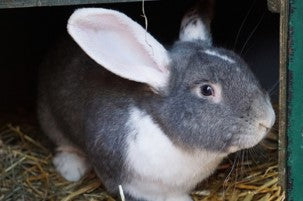Rabbits are not only cherished as adorable pets but also play significant roles in wild ecosystems. Among their most distinctive features are their large, often upright ears. These ears are not just cute; they are highly evolved sensory tools that serve multiple critical functions in a rabbit's survival and behavior. This blog delves into the intriguing aspects of rabbit ears, exploring their evolution, sensitivity, anatomy, function, and the differences among breeds.
Evolution of Rabbit Ears
The evolutionary history of rabbits tells a story of adaptation and survival, with their ears playing a pivotal role. Rabbits belong to the family Leporidae, which also includes hares. The common ancestor of this family likely had a moderate ear size, which, over millions of years, evolved into the diverse ear shapes and sizes seen today. This evolution was driven by environmental factors such as predation pressure and temperature regulation needs.
Larger ears, like those seen in many wild rabbits, enhance auditory sensitivity and help detect predators from afar. This trait is particularly pronounced in open habitats, where early detection of predators can make the difference between life and death. Conversely, rabbits in denser habitats often have smaller ears, which are less likely to snag on vegetation and still provide adequate hearing.
Sensitivity and Function

Rabbit ears are marvels of biological engineering, primarily serving two major functions: hearing and thermoregulation. Each ear contains a complex network of muscles (over 20 muscles per ear), allowing for precise control over ear movement. This muscular system lets rabbits rotate their ears up to 270 degrees to pinpoint the origin of sounds. Such acute hearing enables rabbits to listen for predators, often hearing them before they come into view.
Thermoregulation is another critical function of rabbit ears. The large surface area of the ears, filled with blood vessels, helps to release excess body heat. On hot days, you might see a rabbit's ears turn red as blood flow increases, allowing heat to dissipate more rapidly. This natural cooling system is essential for maintaining their body temperature, particularly for species living in warmer climates.
Anatomy of Rabbit Ears

The anatomy of rabbit ears is specialized to enhance their hearing and cooling functions. Each ear is covered in a thin layer of fur, with the inner surfaces often having less fur to expose the skin, which assists in heat exchange. The external part of the ear, known as the pinna, is supported by a flexible cartilage framework that provides structure while allowing movement.
Inside, the ear canal leads to a sophisticated middle and inner ear system, which houses the mechanisms for sound transmission and balance. Rabbits have a keen sense of balance, thanks in part to their vestibular system located in the inner ear, which works with their visual and proprioceptive systems to help them navigate their environment swiftly and efficiently.
Breed Differences in Ear Characteristics


The diversity in rabbit breeds is reflected in their ears, with variations that influence both appearance and function. For instance, the Flemish Giant, one of the largest rabbit breeds, has proportionately large ears that can be more than 6 inches long. These large ears are not just a breed characteristic but also enhance the rabbit's hearing and thermoregulation capacities.
On the other end of the spectrum are breeds like the Netherland Dwarf, which has much smaller ears. These rabbits are often bred for companionship and pet purposes, where extreme sensory capabilities are less crucial than in wild rabbits. There are also breeds like the Lop, characterized by their distinctive floppy ears. This ear type is a result of a genetic mutation affecting the cartilage, giving the ears their droopy appearance. While charming, lop ears can be prone to more health issues, such as a higher risk of ear infections due to reduced airflow in the ear canal.
Conclusion
Rabbit ears are remarkable not just for their aesthetic appeal but for the complex and vital roles they play in a rabbit's life. From the wide-open plains to the densest forests, the shape, size, and functionality of rabbit ears have evolved to meet the demands of various environments, helping rabbits detect predators, regulate body temperature, and navigate their surroundings. Breeders and pet owners should pay careful attention to the health and maintenance of their rabbits' ears, as they are not only key sensory organs but also indicators of overall health. Understanding these aspects can help us appreciate these fascinating creatures even more and provide them with the care they deserve.
In conclusion, the ears of rabbits are not only a defining feature but also a testament to the complexity of evolution and adaptation. They remind us of the intricate links between form, function, and environment in the animal kingdom.
References:
McNitt, J. I., Lukefahr, S. D., Cheeke, P. R., & Patton, N. M. (2010). The biology of the rabbit. CABI.
Stiefel, M. (1979). Rabbit: A model for the principles of mammalian physiology and surgery. Harcourt Brace Jovanovich.
Richardson, V. (2000). Rabbits: Health, husbandry and diseases. Blackwell Science.
Journal of Exotic Pet Medicine. (Various Issues). Elsevier. Available from https://www.journals.elsevier.com/journal-of-exotic-pet-medicine
House Rabbit Society. (n.d.). Retrieved April 14, 2024, from https://rabbit.org
Journal of Zoology. (Various Issues). Wiley-Blackwell. Available from https://zslpublications.onlinelibrary.wiley.com/journal/14697998
More stories



